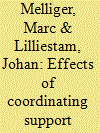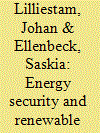|
|
|
Sort Order |
|
|
|
Items / Page
|
|
|
|
|
|
|
| Srl | Item |
| 1 |
ID:
114328


|
|
|
|
|
| Publication |
2012.
|
| Summary/Abstract |
Coal power coupled with Carbon [Dioxide] Capture and Storage (CCS), and Concentrating Solar Power (CSP) technologies are often included in the portfolio of climate change mitigation options intended to decarbonize electricity systems. Both of these technologies can provide baseload electricity, are in early stages of maturity, and have benefits, costs, and obstacles. We compare and contrast CCS applied to coal-fired power plants with CSP. At present, both technologies are more expensive than existing electricity-generating options, but costs should decrease with large-scale deployment, especially in the case of CSP. For CCS, technological challenges still remain, storage risks must be clarified, and regulatory and legal uncertainties remain. For CSP, current challenges include electricity transmission and business models for a rapid and extensive expansion of high-voltage transmission lines. The need for international cooperation may impede CSP expansion in Europe.
|
|
|
|
|
|
|
|
|
|
|
|
|
|
|
|
| 2 |
ID:
176124


|
|
|
|
|
| Summary/Abstract |
The economic context for renewable power in Europe is shifting: feed-in tariffs are replaced by auctioned premiums as the main support schemes. As renewables approach competitiveness, political pressure mounts to phase out support, whereas some other actors perceive a need for continued fixed-price support. We investigate how the phase-out of support or the reintroduction of feed-in tariffs would affect investors’ choices for renewables through a conjoint analysis. In particular, we analyse the impact of coordination – the simultaneousness – of policy changes across countries and technologies. We find that investment choices are not strongly affected if policy changes are coordinated and returns unaffected. However, if policy changes are uncoordinated, investments shift to still supported – less mature and costlier – technologies or countries where support remains or is reintroduced. This shift is particularly strong for large investors and could potentially skew the European power mix towards an over-reliance on a single, less mature technology or specific generation region, resulting in a more expensive power system. If European countries want to change their renewable power support policies, and especially if they phase out support and expose renewables to market competition, it is important that they coordinate their actions.
|
|
|
|
|
|
|
|
|
|
|
|
|
|
|
|
| 3 |
ID:
105756


|
|
|
|
|
| Publication |
2011.
|
| Summary/Abstract |
Solar power imports to Europe from the deserts of North Africa, as foreseen in the Desertec concept, is one possible way to help decarbonising the European power sector by 2050. However, this approach raises questions of threats to European energy security in such an import scenario, particularly in the light of increasing import dependency and Russia's use of the "energy weapon" in recent years. In this paper we investigate the threat of North African countries using the Desertec electricity exports as an "energy weapon". We develop and use a new model to assess the interdependence - the bargaining power symmetry, operationalised as costs - of a disruption in a future renewable electricity trade between North Africa and Europe. If Europe maintains current capacity buffers, some demand-response capability and does not import much more than what is described in the Desertec scenario, it is susceptible to extortion and political pressure only if all five exporter countries unite in using the energy weapon. Europe is not vulnerable to extortion by an export cut from only one country, as the European capacity buffers are sufficient to restore the power supply: no single exporter country would have sustained bargaining power over Europe.
|
|
|
|
|
|
|
|
|
|
|
|
|
|
|
|
| 4 |
ID:
096148


|
|
|
|
|
| Publication |
2010.
|
| Summary/Abstract |
The European Union has yet to determine how exactly to reach its greenhouse gas emissions targets for the future. One potential answer involves large-scale development of concentrated solar power (CSP) in the North African region, transmitting the power to Europe. CSP is a relatively young and little utilized technology and is expensive when compared to other methods of generation. Feasibility studies have shown it is possible to generate enough power from CSP plants in Africa to spearhead the EUs climate goals. However, the costs of such a project are less well known. Currently, CSP must compete with low cost coal-fired electricity plants, severely hindering development. We examine the possible investment costs required for North African CSP levelized electricity cost to equal those of coal-fired plants and the potential subsidy costs needed to encourage growth until the technologies reach price parity. We also examine the sensitivity of investment and subsidies to changes in key factors. We find that estimates of subsidy amounts are reasonable for the EU and that sensitivity to such factors as perceived risk and learning rates would enable policy-makers to positively influence the cost of subsidies and time required for CSP to be competitive with coal.
|
|
|
|
|
|
|
|
|
|
|
|
|
|
|
|
| 5 |
ID:
127904


|
|
|
|
|
| Publication |
2014.
|
| Summary/Abstract |
The decarbonised future European electricity system must remain secure: reliable electricity supply is a prerequisite for the functioning of modern society. Scenarios like Desertec, which partially rely on solar power imports from the Middle East and North Africa, may be attractive for decarbonisation, but raise concerns about terrorists interrupting supply by attacking the long, unprotected transmission lines in the Sahara. In this paper, I develop new methods and assess the European vulnerability to terrorist attacks in the Desertec scenario. I compare this to the vulnerability of today's system and a decarbonisation scenario in which Europe relies on gas imports for electricity generation. I show that the vulnerability of both gas and electricity imports is low, but electricity imports are more vulnerable than gas imports, due to their technical characteristics. Gas outages (and, potentially, resulting blackouts) are the very unlikely consequence even of very high-number attacks against the gas import system, whereas short blackouts are the potential consequence of a few attacks against the import electricity lines. As the impacts of all except extreme attacks are limited, terrorists cannot attack energy infrastructure and cause spectacular, fear-creating outages. Both gas and electricity import infrastructure are thus unattractive and unlikely terrorist targets.
|
|
|
|
|
|
|
|
|
|
|
|
|
|
|
|
|
|
|
|
|